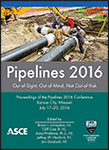Populating Utility Risk Envelopes
Publication: Pipelines 2016
Abstract
Existing utilities of all kinds are depicted on planning and design documents for the use of the design engineer. The intent of the depiction is to assist the design engineer in (a) understanding the physical characteristics, availability, and restrictions of the space to develop and design the project and (b) judging the risk that a particular utility may present for a particular project feature or phase. Engineers can choose to address that risk in several ways: designing the project in such a way so that there is no design element of the project in conflict with the utility; requiring the utility to relocate; or designing protections for the utility during construction activities. However, utility depictions and the environment in which the utility exists are uncertain. This uncertainty makes judgements on reducing risk difficult. ASCE 38 was developed to allow the engineer some degree of confidence that the utility location information is accurate, but this location information and its attribute of utility quality level (as per ASCE 38) are not sufficient for complete risk evaluation. Other uncertainties about utilities exist beyond location that should be evaluated by the design engineer. These uncertainties may include a utilities’ size; ability to withstand stress; soil and bedding characteristics; and structural devices such as thrust blocks and other restraints. Other risk factors that affect design include a utilities’ product, operating pressure, function (e.g. main water supply for a hospital), ability to recover from a catastrophic event, and so on. New software programs, especially 3D modeling ones, have a mechanism to expand a programmed shape like a square or round cylinder that mimics the anticipated shape of the utility beyond the location of that utility. This concept is termed a “soft” clash detection. However, due the uncertainties of location, size, condition, structures, and other factors as outlined above, a symmetrical risk envelope may not be the best solution from a risk mitigation standpoint. Knowledge of utility system design, utility operational and maintenance constraints, project construction practices, achieved utility quality level, and system and community resilience are necessary to judge the best shape and extent of any risk envelope placed around utility elements. Determining the shape and extent of these utility risk envelopes is a new development in the field of utility engineering that will allow the design engineer to exercise better judgement in utility risk elimination and reduction.
Get full access to this article
View all available purchase options and get full access to this chapter.
Information & Authors
Information
Published In
Copyright
© 2016 American Society of Civil Engineers.
History
Published online: Jul 14, 2016
Authors
Metrics & Citations
Metrics
Citations
Download citation
If you have the appropriate software installed, you can download article citation data to the citation manager of your choice. Simply select your manager software from the list below and click Download.
